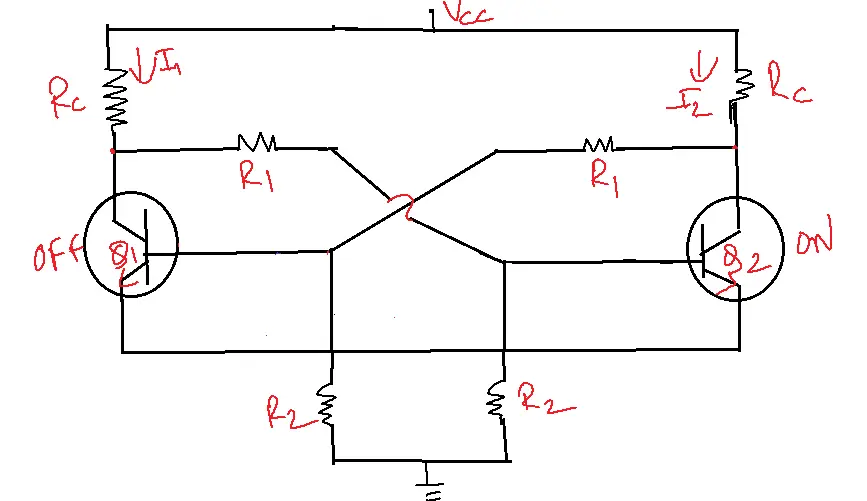A Bistable Multivibrator is an electronic circuit that can maintain two stable states, with no external trigger required to switch between them. It is a fundamental component in digital electronics and various applications such as flip-flops, counters, and memory devices.
It has two stable states. The resistor is a coupling element.
It requires a triggering signal to change from one state to another.
Table of Contents
Working Principle
A Bistable Multivibrator consists of two cross-coupled logic gates or transistors, which create a feedback loop. This loop allows the circuit to maintain two stable states, with no external trigger required to switch between them.
Characteristics
– Maintains two stable states
– No external trigger is required to switch between states
– Can be triggered by an input signal
– Can be used as a memory device
Collector-coupled bistable multivibrator
Also called as
1. multi
2. Eecles-Jordan circuit
3. Trigger Circuit
4. Scale of two trigger circuit
5. Flip Flop Circuit
6. Binary circuit.
Fixed bias bistable multivibrator

Operation
If I1 ≠ I2
Minute fluctuation
Initially I1>I2
Then I1 increases.
I1RC also increases. Then Vc1 decreases, IB2 also decreases then Q2=OFF.
If IB2 decreases, then I2 decreases I2RC decreases, and Vc2 decreases.
Then IB1 goes on to increase. Then Q1=ON.
Self Bias Bistable Multivibrator

Triggering the Binary
A bistable Multivibrator has two stable states that can remain indefinitely in one of the states.
Applying an external signal to induce a transition from one state to another is called triggering.
Triggering Methods
1. Unsymmetrical Triggering: The triggering signal is productive and induces a transition in one direction. It requires two separate sources. It can be used as an interval between the triggers.
2. Symmetrical Triggering: It is one in which each such successive triggering signal induces transition regardless of state. It requires only one source. It is used in binary counting circuits.
Advantages of Bistable Multivibrator
1. Simple Design: These multivibrators have a relatively simple design, making them easy to implement.
2. Low Power Consumption: They consume low power, making them suitable for battery-powered devices.
3. High Accuracy: These multivibrators provide high accuracy in maintaining two stable states.
4. Wide Range of Applications: They are used in various digital circuits, such as flip-flops, counters, and memory devices.
5. Memory Function: These multivibrators can be used as memory devices, storing binary information.
Disadvantages of Bistable Multivibrator
1. Limited Flexibility: These multivibrators can only maintain two stable states, limiting their flexibility.
2. Sensitivity to Component Values: Output states are sensitive to component values, requiring precise selection.
3. Prone to Noise and Interference: These multivibrators can be susceptible to noise and interference, affecting output accuracy.
4. No Control Over Switching: No easy control over switching between states.
5. Requires External Trigger: Requires an external trigger to switch between states (except for some designs).
Applications
- Memory Elements: These multivibrators store one bit of data (‘0’ or ‘1’) in digital systems, making them vital for memory devices like registers and counters.
- Frequency Dividers: These multivibrators, used in clock circuits and digital synthesizers, divide input signal frequencies for precise control.
- Counters and Timers: Cascading bistable multivibrators enable the creation of counters, timers, and control signals, vital for digital systems and automation.
- Data Storage and Transfer: These multivibrators store and transfer digital data in circuits, acting as buffers, synchronizers, and shift registers.
- Sequential Logic Circuits: These multivibrators are the basis of sequential logic circuits like state machines, enabling complex digital systems with memory and decision-making abilities.
FAQs
1. What is a bistable multivibrator?
- A bistable multivibrator, or flip-flop, is an electronic circuit capable of maintaining two stable states.
- It can store one bit of binary information (0 or 1) and remains in one state until triggered to switch to the other.
2. How does a bistable multivibrator work?
- These multivibrators typically use two cross-coupled transistors or logic gates.
- When one transistor/gate is ON, the other is OFF, creating two stable states.
- An external trigger pulse is needed to change the output from one state to another.
3. What are the different types of bistable multivibrators?
- There are several types of bistable multivibrators, including:
- SR flip-flop (Set-Reset): The most basic type, triggered by Set and Reset inputs.
- D flip-flop (Data): Stores the value of the D input when the clock signal transitions.
- JK flip-flop: A versatile flip-flop with more complex triggering behavior.
- T flip-flop (Toggle): Changes state on each active clock edge.
4. What are the applications of bistable multivibrators?
- Bistable multivibrators have numerous applications in digital circuits:
- Memory elements: Form the basis of registers, counters, and other storage devices.
- Frequency dividers: Reduce the frequency of an input signal.
- Counters and timers: Used to count events and measure time intervals.
- Data storage and transfer: Buffer and synchronize data in digital systems.
- Sequential logic circuits: Implement state machines and complex digital systems.
5. What are the advantages of bistable multivibrators?
- Simple design: They are relatively simple to design and implement.
- Stable states: They maintain their output state indefinitely until triggered.
- Versatility: They can be used in various applications, from basic memory to complex sequential logic.
- Essential for digital systems: They are fundamental building blocks of digital electronics.
